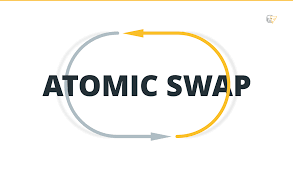Atomic Swap: What is it and how does it work?
Centralized exchanges have become a crucial part of our crypto experience.
We rely heavily on them. However, they are not secure and can also come with pretty decent-sized disadvantages attached.
Meet Atomic Swap, a mechanism through which one cryptocurrency can be traded/exchanged for another one without the need to trust a third-party. This is groundbreaking as it can completely change how we trade or exchange different or same currency.
Outline
- History Behind the Atomic Swap
- Centralized Exchanges – Why they are not enough?
- What are Atomic Swaps?
- How Atomic Swap works?
- Hashed Time Contracts
- What is the current state of atomic swaps?
- Conclusion
History Behind the Atomic Swap
The idea behind the atomic swap is not new. It was a hot topic near 2012 when Sergio Demian Lerner drafted a trustless exchange protocol. It was just the beginning. However, in 2013, Tyler Nolan came forward and finished the idea into a full-fledged concept of atomic swaps. Hence, he is regarded as the inventor of atomic swaps.
So, why even are atomic swaps needed? Let’s take a look at the problems attached to centralized exchanges to get a clearer picture.
Centralized Exchanges – Why they are not enough?
In this day and age, centralized exchanges are seen as a lifesaver for most of the novice users out there. But, they also bring a lot of issues with them. Generally, if two users want to exchange coins, they need to exchange to do the ordeal. It does the job, but it requires a series of steps to get it done. Apart from it, there are many other issues that a centralized exchange suffers from. Let’s have a quick rundown of the problems with exchanges.
Mismanagement: Centralized exchanges can be a threat to themselves. One such example is the infamous Mt.Gox Hack. It resulted in the loss of $500 million due to poor management by none other than the CEO of the exchange.
Hack: Clearly, centralized exchanges are susceptible to hacks and many exchanges have been hacked until now. The centralized aspect makes them more vulnerable and is also against the core philosophy of blockchain, i.e., decentralization.
Government Regulations: Governments are keen to learn about anything that is centralized. Also, centralized exchanges need registration which makes it easy for the government to govern these exchanges.
What are Atomic Swaps?
 <center/. >
<center/. >
Atomic swap is a peer-to-peer protocol that allows cryptocurrency exchange from one peer to another without the need for centralized third-party service. The user is in full control during the whole process and also possess private keys ownership. It is also known as “cross-chain trading.”
Atomic swaps are decentralized and hence are not prone to the problems that the centralized exchanges offer. The word, “atomic” means that it is an individual or whole transaction without the need of a centralized entity.
Is atomic swap completely free? If you can do it, yes it is. However, it is not easy to do as it requires command line execution. That means you might have to pay small fees if you take help of services that let you do an atomic swap in the first place. These services are decentralized and ensure that the concept of atomic swap is well implemented.
How does Atomic Swap work?
Now, that we have understood what an atomic swap is we’re ready to learn how it actually works. Atomic swap is simplistic. It is a peer-to-peer transfer, and the whole transaction depends on a shared secret. The shared secret is only known to the two parties, and no one else can get access to it. This also means that the 3rd party has no control over the transaction and cannot interfere as they do not have access to the shared secret.
But, what makes it all possible? Technically? Hashed Timelock Contracts or HTLCs make it all possible. They are also a core part of the lightning network. Let’s explore more about Hashed Timelock Contracts below.
Hashed Time Contracts
Hashed Time Contracts are payment channels that can be run off-chain to deal with payments.
To make the payments, a state channel is opened during the transaction. It is a two-way communication which means that both peers need to take part in the interaction to get started. By using an off-chain channel, the transaction time is drastically decreased as it no longer depends on the third-party intervention.An off-chain state channel needs to be operated to do all of these. To do so, some requirements need to be met. They include the following:
Blockchain state segment is locked using a smart contract or a multi-signature with agreed upon participants.
Once locked, the participants sign transactions to interact with each other. They do it without the need for any miners.
Lastly, the entire transaction is added to the blockchain.
The state channel is then closed after the transaction is complete. This is done to ensure if the time set elapses or the transaction limit is reached.
HLTCs are specially built on top of the state channel which uses “timelocks.” They are extended with the help of hash locks which in turn ensure that the transaction is done successfully before closing the state channel.
What is the current state of atomic swaps?
So, what is the current status of atomic swaps? Currently, they aren’t widely used, but do offer a unique way to handle transactions. Also, the cryptocurrency must use the same hash algorithm and also support lock contracts. Another limitation is the skill required to use a programming language to execute atomic swaps.
Once these issues are rectified, atomic swaps can become mainstream, but for now, the concept is mainly used by businesses.
Conclusion
Atomic swaps are here to stay. With time, we will see more adoption around the use of atomic swaps and the rise of decentralized exchanges. After all, atomic swaps provide privacy and security without the need for a centralized exchange.
So, what do you think about the atomic swap? Will it change the future of how we do transactions or it will stay as a concept that is mainly used by businesses? Comment below and let us know.






